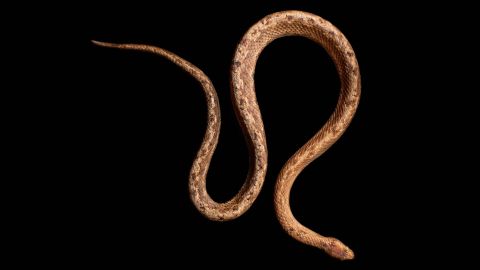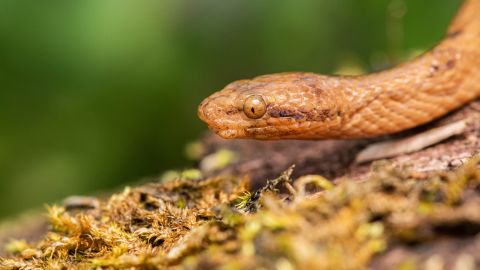Sign up for CNN’s Wonder Theory science newsletter. Explore the universe with news on fascinating discoveries, scientific advancements and more.
Scientists have identified a tiny new species of dwarf boa living in the Ecuadorian Amazon that even a snake hater could love: These small reptiles are just a foot long.
Alex Bentley, research coordinator of the Sumak Kawsay In Situ field station in the eastern foothills of the Andes, stumbled across a small, curled up snake in a patch of cloud forest, an upland forest where clouds filter through the treetops.
He sent a photo of the snake to colleagues, including Omar Entiauspe-Neto, a graduate student at the Federal University of Rio Grande do Sul and Butantan Institute in Brazil.
‘Radically different’
“We were immediately surprised, because it shouldn’t be there,” said Entiauspe-Neto, the corresponding author of the paper describing the species in the European Journal of Taxonomy.

Other dwarf boas have been identified elsewhere in South America and the West Indies, but none had ever been found in the region where Bentley spotted this one. The closest known match in Ecuador lives west of the Andes, and, according to Entiauspe-Neto, it looks “radically different” from the specimen in Bentley’s photo.
While the snake didn’t match any known species of dwarf boas, it had a lot in common with a specimen in the Ecuadorian Museum of Natural Sciences collected several years ago.
“We’re usually afraid to describe new species based on only a single one, because there’s a chance that there might be some sort of variation,” Entiauspe-Neto said. “Once we had those two specimens, we were fairly sure they were a new species.”

By comparing both the physical characteristics and genetic sequences of the mystery snakes with known species, the researchers determined that they’d found an animal new to science. They named it Tropidophis cacuangoae in honor of Dolores Cacuango, an Indigenous activist who championed women’s rights and founded Ecuador’s first bilingual schools with lessons in Spanish and the Indigenous language Quechua.
Distant boa cousins
Like its fellow dwarf boas, T. cacuangoae is distantly related to the bigger boa constrictor, but they have key traits in common.
They both have thickset bodies, and their skeletons bear vestigial hip bones, relics of snakes’ ancient legged ancestors. And instead of being armed with venom, they squeeze their prey to death, blocking blood flow and causing cardiac arrest.
While 10-foot-long boa constrictors go after animals as big as wild pigs, dwarf boas have diets that largely consist of small lizards. And since they don’t have size on their side like true boa constrictors, dwarf boas have evolved a strange defense mechanism: When threatened, they curl into a ball and bleed out of their eyes.
This behavior, also seen in horned lizards, might appear more gross than threatening, but Entiauspe-Neto suspects the behavior is part of a bigger constellation of death feigning found throughout the animal kingdom.
“Most predators tend to feed on living prey,” he said. If a predator such as an eagle sees a dwarf boa coiled up and bleeding from its eyes, “the predator is very likely to think that the snake might be either sick or dying, so therefore it will not feed on it” to avoid catching whatever made the snake seem ill.
However, dwarf boas face far bigger threats than predators: The newly identified species may already be endangered due to habitat loss. “It has a fairly small range,” Entiauspe-Neto said. “So while it still needs to be formally evaluated by the IUCN (International Union for Conservation of Nature), I think it might be threatened with extinction.”
Thaís Guedes, a researcher at the State University of Campinas in Brazil who was not involved with the study, praised the work. “I am always happy when I see a new species of snake being introduced to the world,” Guedes said.
Honoring activist Cacuango in the naming of the species is also important, she said, since Indigenous peoples play a key role in conservation.
Kate Golembiewski is a freelance science writer based in Chicago who geeks out about zoology, thermodynamics and death. She hosts the comedy talk show “A Scientist Walks Into a Bar.”
Article From & Read More ( Foot-long dwarf boa found in Ecuadorian Amazon - CNN )https://ift.tt/fOY3r69
Science


No comments:
Post a Comment